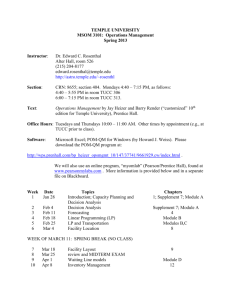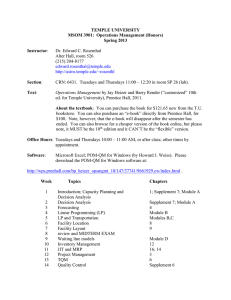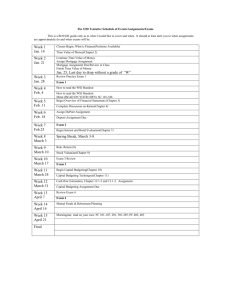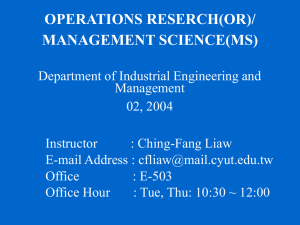MSOM 5001 syllabus - The Astro Home Page
advertisement
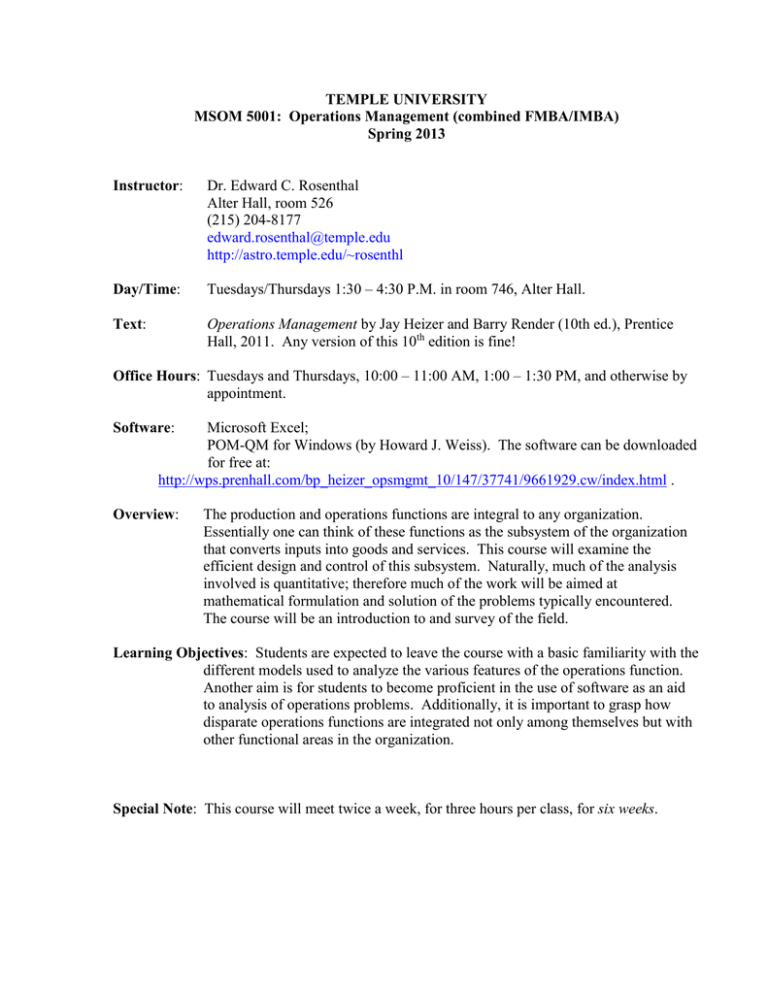
TEMPLE UNIVERSITY MSOM 5001: Operations Management (combined FMBA/IMBA) Spring 2013 Instructor: Dr. Edward C. Rosenthal Alter Hall, room 526 (215) 204-8177 edward.rosenthal@temple.edu http://astro.temple.edu/~rosenthl Day/Time: Tuesdays/Thursdays 1:30 – 4:30 P.M. in room 746, Alter Hall. Text: Operations Management by Jay Heizer and Barry Render (10th ed.), Prentice Hall, 2011. Any version of this 10th edition is fine! Office Hours: Tuesdays and Thursdays, 10:00 – 11:00 AM, 1:00 – 1:30 PM, and otherwise by appointment. Software: Microsoft Excel; POM-QM for Windows (by Howard J. Weiss). The software can be downloaded for free at: http://wps.prenhall.com/bp_heizer_opsmgmt_10/147/37741/9661929.cw/index.html . Overview: The production and operations functions are integral to any organization. Essentially one can think of these functions as the subsystem of the organization that converts inputs into goods and services. This course will examine the efficient design and control of this subsystem. Naturally, much of the analysis involved is quantitative; therefore much of the work will be aimed at mathematical formulation and solution of the problems typically encountered. The course will be an introduction to and survey of the field. Learning Objectives: Students are expected to leave the course with a basic familiarity with the different models used to analyze the various features of the operations function. Another aim is for students to become proficient in the use of software as an aid to analysis of operations problems. Additionally, it is important to grasp how disparate operations functions are integrated not only among themselves but with other functional areas in the organization. Special Note: This course will meet twice a week, for three hours per class, for six weeks. Weekly Schedule: the course begins Tuesday, January 22, 2013. Week 1. T Jan 22. We will first have an introduction to the course, describing what the course is about (including some background), what the learning objectives are, how the course will be conducted, and so on. Then we will introduce the first operations topic, capacity planning, and we will apply two techniques commonly applied to capacity planning problems: decision trees and break-even (cost-volume) analysis. Reading: Chapter 1 (Introduction); Supplement to Chapter 7 (Capacity planning); Module A (Decision analysis). Th Jan 24. We will wrap up the capacity planning topic, and then we will begin to study forecasting. We will discuss forecasting approaches (causal and time series) and introduce notions such as trend, seasonality, and forecast error. We will carry out time series forecasts in Excel using moving averages and exponential smoothing techniques, and move on to the more general use of linear regression and multiple regression. Reading: Chapter 4 (Forecasting). Week 2. T Jan 29. First we will review the HW problems on capacity planning and forecasting, and then move on to the next topic: linear programming. Linear programming is a powerful quantitative technique that we will use to solve production planning problems and staffing problems. Reading: Module B (Linear programming), Module C (Transportation). Th Jan 31. First, we will briefly focus on a type of transportation problem that introduces the importance of logistics in modern-day operations. We will then look at problems of facility location. We will discuss what factors are important when organizations need to locate a new facility, and we will present two models that are used to select sites for facilities such as processing plants, warehouses, and service sites. Reading: Module C (Transportation), Chapter 8 (Facility location). Week 3. T Feb 5. We will go over the HW on linear programming, transportation, and facility location. We will then discuss process design and analysis. Specifically, we will learn how to efficiently design process flows in production and service situations where activities are carried out in a sequential fashion. These ideas focus on identifying bottlenecks in systems, as well as how the breaking down of tasks decreases operation “cycle times,” thereby increasing output. Th Feb 7. We will go over HW on process flows and then begin the study of queueing, or waiting line, analysis, which is an important weapon in providing customer satisfaction in the service industry. Reading: Chapter 9 (Facility layout), Module D (Queueing). Week 4. T Feb 12. Review and MIDTERM EXAM. Note: an informal proposal for your term paper will be due. (More on this below.) Th Feb 14. We will finish the queueing topic, in which we study systems of arrivals (of customers) and services performed for them. The main thrust is to determine staffing levels that adequately solve the trade-off between the higher cost of increasing staff vis-à-vis the improved service provided. Then we will begin studying inventory management, which is of central importance in the study of supply chain management. We will introduce the classic reasons why too much inventory, or too little inventory, are bad for a company’s performance, and then we will proceed with the standard EOQ model used to solve this trade-off. We will also study important variations of the EOQ model; in particular, we will study a purchasing manager’s problem of ordering stock when a supplier offers quantity discounts, and we will study how to buffer oneself against market uncertainties by using safety stock. Reading: Module D (Queueing), Chapter 12 (Inventory). WEEK OF FEB. 18: NO CLASS (DESIGN WEEK) Week 5. T Feb 26. After going over the queueing homework, we will continue studying inventory. We will go over HW from the previous week, and then we will explore the ideas behind the notion of “just-in-time” (JIT) ordering policies. We will briefly extend the scope of the inventory topic by introducing material requirements planning (MRP), including its relationship to ERP systems. If time permits, we will close out the supply chain topic by considering some more strategic factors, such as crossdocking, supply chain design, consolidation, and the bullwhip effect. Reading: Select parts of Chapter 13 and Chapter 14, and class notes. Th Feb 28. We will have an introduction to project management. We will use PERT and CPM techniques to develop timelines and schedules for sets of interrelated tasks. We will also discuss “crashing” and certain issues of moral hazard that challenge project managers. Reading: Chapter 3 (Project management). Week 6. T Mar 5. After reviewing the HW on project management, we will have a two-part introduction to the subject of quality. We will highlight the main concepts in total quality management (TQM), and then will study statistical process control, including x-bar charts, R charts, and p charts. Reading: Chapter 6 (Quality management/TQM) and Supplement 6 (Statistical process control). Th Mar 7. Review and FINAL EXAM (2 hours). Prerequisites: introductory statistics, such as taught in the MBA “boot camp” in August. Notes: (1.) Bring a USB flash drive to class so that you can save files! (2.) The class notes are available on our class’s Blackboard (Bb) site under “Course Documents.” Please download this file (152 pages in Word) and print it out as soon as possible. A hard copy of the class notes is essential to the course. (3.) We will be using the Blackboard site for the class for weekly communication and posting of files. (4.) Please do not eat or drink in the classroom. Grading: Midterm exam (30%) of course grade. Final exam (40%). The final exam will be comprehensive. Class Presentation (7.5%). Each team will make a 5-10 minute presentation to the class from a media article on operations management. (More below.) Team Homework (12.5%). There will be one lengthy HW assignment that I will collect and grade. (Note, however, that the rest of the assigned HW will not be collected or graded.) Team Term Paper (10%; more below). Exams: For both exams, the computer will be available as a tool for you to carry out necessary analysis. The exams will be open book as well (i.e., free access to your textbook, notes, files, etc.) However, you are not allowed to use the Internet (email, etc.) during exams. Homework: Most HW assignments will not be collected but are an essential part of the course. It is imperative that you keep up with these and master the assigned problems. However, there will be a single HW assignment, worth 10% of the course grade and covering topics from across the semester, to be distributed halfway through the semester and submitted on the last day of class. Class Presentation: In addition to mainstream media sources (NY Times, WSJ, etc.) that occasionally feature articles on operations management, there are many more specialized print and online publications that focus on various business disciplines. These publications frequently feature articles on operations management. Your team task for the class presentation is to find an interesting, and recent, article or two featuring a topic from our course, and present it to the class. You will probably want to use PowerPoint as a presentation tool but this is not required. Handouts might also be an option but are not necessary. Your job is to convey, in a short amount of time (5-7 minutes), what the development was as described in the article(s), so that our fellow classmates will receive a concise and organized lesson – something that they can “take away” and describe, in turn, to others. WHAT is a TEAM? The “teams” that will do the HW, presentation, and term paper assignments will be the FOUR – FIVE PERSON TEAMS IN WHICH YOU ARE ALREADY GROUPED. Term Paper: Process Improvement. My concept for the paper: for you to research and report on a recent development in operations management. This development is the improvement of some process or function in an industry or in a specific company. (The company can even be one you work (or have worked) for, provided you are able to obtain sufficient documentation.) By “research” I mean you will have to resort to a number of sources -- e.g., journal, newspaper, or magazine articles, data collected from a company or companies, etc. By “report” I mean to write a 7 -10 page (or so) paper that details the IMPROVEMENTS that you have documented through your sources. You'll need an INTRODUCTION, which describes what the topic of your paper is about, you'll need to detail the PAST STATE of the company's (or industry's, etc.) operations, you'll need to detail WHAT THEY DID to improve things, and you'll need a CONCLUSION that not only summarizes what they did but also provides INSIGHT into how and why things improved, by how much (e.g., in $ saved), whether these improvements can be extended, etc. You don't formally have to divide your paper into these sections but the flow of ideas ought to be there. If you have any questions about a potential topic, please run it by me! By the way, when I say 7 - 10 pages, I mean papers that are written (and submitted electronically) in Word and are double-spaced using "normal" font (10 or 12 point) and "normal" margins (1 inch all around) on "normal" 8.5 x 11'' pages. (Your paper doesn't HAVE to be ten pages but if it is too short, you won't be able to fully present a process improvement along with any analysis.) Finally: The following is taken from Temple University’s policies on student and faculty rights: Disability Statement: This course is open to all students who meet the academic requirements for participation. Any student who has a need for accommodation based on the impact of a disability should contact the instructor privately to discuss the specific situation as soon as possible. Contact Disability Resources and Services at 215-204-1280 in 100 Ritter Annex to coordinate reasonable accommodations for students with documented disabilities. Statement on Academic Freedom: Freedom to teach and freedom to learn are inseparable facets of academic freedom. The University has adopted a policy on Student and Faculty Academic Rights and Responsibilities (Policy # 03.70.02) which can be accessed through the following link: http://policies.temple.edu/getdoc.asp?policy_no=03.70.02
